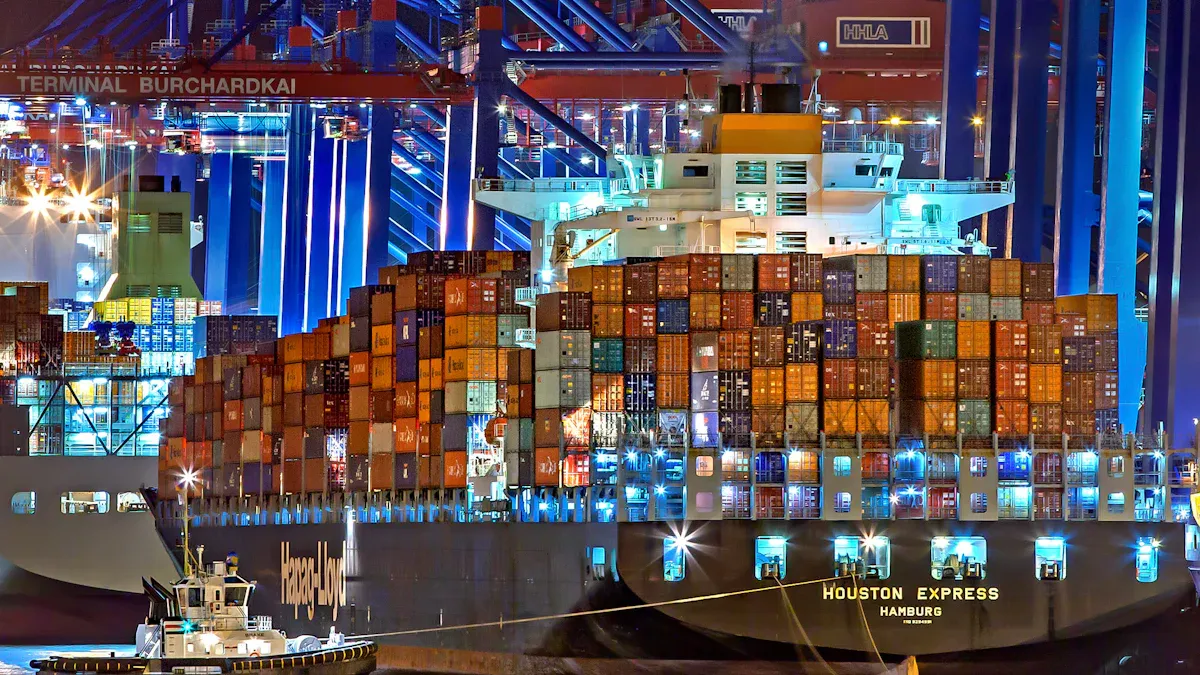PGL's Expertise in LTL and FTL Freight Shipping Solutions

Choosing the best shipping method can improve your business. PGL focuses on LTL and FTL freight services, helping companies in the U.S. If you need affordable LTL or dedicated FTL shipping, PGL makes sure your items arrive on time. Things like delivery speed and few damaged goods prove how important good freight carriers are for happy customers and profits. With big 53’ trucks for full loads, PGL handles both small and large shipments easily.
Key Takeaways
LTL shipping saves money by sharing truck space for small loads.
FTL shipping is quicker for big or delicate items, keeping them safe.
PGL uses smart tools to track shipments live, avoiding delays.
Picking the right shipping type makes customers happy and boosts profits.
LTL and FTL shipping are green choices that cut fuel use and pollution.
Understanding LTL and FTL Freight Shipping

What is LTL Freight Shipping
LTL, or less-than-truckload shipping, is for smaller shipments. It combines goods from different businesses into one truck. This way, you share costs with others, saving money. It’s a smart choice for businesses with small freight needs.
LTL carriers work to make shipping cheaper and faster. They predict changes in shipment volumes to improve efficiency. Many also focus on eco-friendly practices, which customers like. If your business ships small loads often, LTL is flexible and affordable.
What is FTL Freight Shipping
FTL, or full truckload shipping, is for large shipments. The whole truck is used for one shipment only. This means faster delivery and less handling of goods. FTL is great for big shipments or fragile items needing extra care.
FTL makes up 46.4% of the freight market. Its popularity grows with e-commerce and new technology. As businesses expand, they need more FTL shipping. It ensures goods arrive quickly and safely.
What is Drayage Freight Shipping
Drayage shipping moves goods short distances, like between ports and warehouses. It’s important for connecting different types of transportation, like ships and trucks. Drayage helps goods move smoothly through the supply chain.
For example, PGL offers drayage services in busy areas like Los Angeles. This helps businesses move goods efficiently. If your supply chain uses ports or rail, drayage keeps things running smoothly.
What is OTR Freight Shipping
OTR means over-the-road freight shipping. It uses trucks to move goods far distances. This connects businesses in different cities and states. OTR delivers cargo straight to its destination. It does not use trains or planes. This method works well for flexible and dependable deliveries.
OTR shipping can carry many types of freight. It moves food, big machines, or regular items. Advanced tools make OTR shipping better. For example, tracking lets you see where your shipment is. This helps you plan ahead.
Studies show load factor is important in OTR shipping. High load factor makes shipments faster and cheaper. It also improves how well operations work. Machine learning helps find problems in shipments. It fixes issues early to keep deliveries on time and safe.
Common Use Cases for LTL, FTL, Drayage, and OTR
Each shipping type fits different business needs. Knowing these helps pick the best one:
LTL (Less-Than-Truckload): Good for small shipments that don’t fill a truck. It saves money by sharing truck space with others.
FTL (Full Truckload): Great for big shipments needing their own truck. It delivers faster and protects fragile or costly items.
Drayage: Useful for short trips, like moving goods from ports to warehouses. It’s key for businesses using imports or exports.
OTR (Over-the-Road): Best for long trips across states. It handles many freight types, like food or heavy equipment.
Choosing the right shipping method saves money and time. It also makes customers happier.
Advantages of LTL vs. FTL Freight Shipping
Cost-Efficiency of LTL and FTL
Picking the right shipping method saves money. LTL shipping is cheaper for small loads. You share truck space with others and pay less. For example, a company in Louisville saved money by matching LTL shipments with warehouse changes.
FTL shipping is better for big or fragile items. It avoids extra handling, so goods are safer. LTL works well for 1-6 pallets, while FTL is best for 12+ pallets or delicate goods. Both methods save money based on shipment size and needs.
Shipping Method | Load Size | Cost Savings | Handling |
|---|---|---|---|
LTL | 1-6 pallets | Great for small loads | More handling |
FTL | 12+ pallets or fragile items | Best for big loads | Less handling |
Flexibility in Freight Shipping
LTL and FTL shipping are flexible for different needs. LTL lets you send small loads often. This helps with changing or seasonal demands.
FTL is good for fast delivery and large or special items. Whether you need regular LTL or dedicated FTL, picking the right option keeps things running smoothly.
Environmental Benefits of Shared and Dedicated Loads
Both LTL and FTL help the environment. LTL combines loads, cutting fuel use and emissions. Fewer trucks mean less traffic and noise.
FTL uses full trucks for big shipments, saving fuel by reducing trips. Choosing the right shipping helps your business and the planet.
Fewer trucks mean less pollution and noise.
Full trucks lower the carbon impact of shipping.
Key Differences Between LTL and FTL Freight Shipping
Cost Comparison
Knowing the costs helps when picking LTL or FTL shipping. LTL freight shares truck space with others, lowering costs for small loads. Prices depend on freight class, which is based on weight, size, and how fragile items are. FTL freight has simpler pricing. You pay for the whole truck, no matter the space used. This makes FTL great for big or valuable shipments where steady costs are important.
Here’s a simple cost comparison of both methods:
Aspect | Full Truckload (FTL) | Less than Truckload (LTL) |
|---|---|---|
Freight Class | Fewer rules about item details; basic pricing applies. | Rates vary by item type; sorted by freight class. |
Accessorial Charges | Fewer extra fees since the truck is fully dedicated. | Extra fees for delays or issues are more common. |
Transit | Direct delivery; faster and more predictable times. | Longer trips with stops; less predictable timing. |
Think about your shipment's size and urgency when comparing costs. LTL is better for small loads, while FTL saves money on bigger shipments. Picking the right one balances cost and speed.
Delivery Times and Speed
Delivery speed is a big difference between LTL and FTL. FTL freight goes straight from pickup to delivery. This makes it faster and ensures goods arrive quickly. It’s perfect for urgent shipments or when exact delivery dates matter.
LTL freight makes several stops to pick up and drop off goods for others. This shared system takes longer. If your shipment isn’t in a rush, LTL is a cheaper option. For tight schedules, FTL gives the speed and reliability you need.
Handling and Shipment Size
Handling is another key difference between LTL and FTL shipping. FTL keeps your shipment on one truck the whole time. This lowers the chance of damage, making it good for fragile or expensive items. FTL’s dedicated service means less handling and more safety.
LTL freight involves more handling. Your shipment might be loaded and unloaded several times at different stops. This helps share costs but increases the risk of damage. LTL works well for small shipments that don’t need special care. For bigger or delicate loads, FTL offers better protection.
When choosing between LTL and FTL, think about your shipment’s size and care needs. FTL is best for large or fragile items, while LTL is flexible for smaller, less sensitive goods.
How PGL Improves Full Truckload and Less-Than-Truckload Shipping
Using Technology to Make Freight Better
Technology helps make shipping faster and easier. PGL uses smart tools to track shipments and improve operations. Real-time data shows where your freight is and helps you plan better. Predictive tools choose the best routes and avoid delays, so your goods arrive on time.
Automation makes hard tasks simple. These systems cut mistakes and save time. For example, PGL Connect, their special platform, helped NEO Tech save money and deliver faster by combining shipments and reducing paperwork costs.
With advanced technology, you get more control over shipping. You can track shipments and see detailed reports. PGL uses technology as a powerful tool to keep your shipping smooth and reliable.
Focused on Customer Needs
PGL puts your needs first with custom shipping solutions. Whether you need full truckload or less-than-truckload services, PGL adjusts to fit your business. They make sure every shipment gets special care.
For example, PGL worked with Pier 1 to improve shipping plans. They used smart software to cut freight costs in half. This shows how PGL focuses on saving you money and making things efficient.
You’ll get clear updates and helpful support. PGL’s team keeps you informed during the shipping process. Real-time updates and quick responses ensure your freight arrives as planned. With PGL, you have a partner who cares about your success.
Skilled in Handling Big Shipments
Handling big shipments takes skill and experience. PGL is great at managing large loads with care and accuracy. For example, they worked with A-Gas to handle 100 pallets perfectly during a test program.
After this, A-Gas trusted PGL with more work. In six months, PGL managed 600 more pallets and improved inventory tracking. Now, they handle up to 26 full containers monthly and send over 25 shipments daily. This shows how PGL can grow while keeping quality high.
PGL works across the U.S., offering services like port drayage in Los Angeles and long-distance trucking from New York to Seattle. Their skills in managing big operations mean your shipping is handled with care and precision.
Picking the right shipping method helps your business grow. LTL shipping is cheaper for small loads. FTL shipping is faster for big shipments. Both are flexible and eco-friendly. PGL uses smart trucking and custom services to help you. They make sure your goods arrive safely and on time. Working with PGL means dependable shipping and less stress.
🚚 Want easier shipping? Trust PGL to handle your freight with care.
FAQ
What is the difference between LTL and FTL shipping?
LTL shipping combines small loads from different businesses in one truck. This saves money by sharing space. FTL shipping uses one truck for a single shipment. It delivers faster and handles goods less. Use LTL for small loads and FTL for big or fragile ones.
How does PGL ensure timely deliveries?
PGL uses tools to track shipments in real time. They plan routes to avoid delays and keep things on schedule. Their team works across the country to ensure smooth operations. Technology keeps you updated on your shipment’s progress.
Can PGL handle both short and long-distance shipments?
Yes! PGL offers drayage for short trips, like moving goods from ports to warehouses. For long trips, they provide OTR shipping across states. Their services are flexible to meet all your shipping needs.
Are PGL’s services eco-friendly?
Yes! LTL shipping saves fuel by combining shipments into fewer trucks. FTL reduces trips by filling trucks completely. PGL’s efficient methods lower pollution and support greener shipping.
How can I track my shipment with PGL?
PGL has a platform for real-time tracking. You can see where your shipment is and when it will arrive. Updates keep you informed every step of the way.
